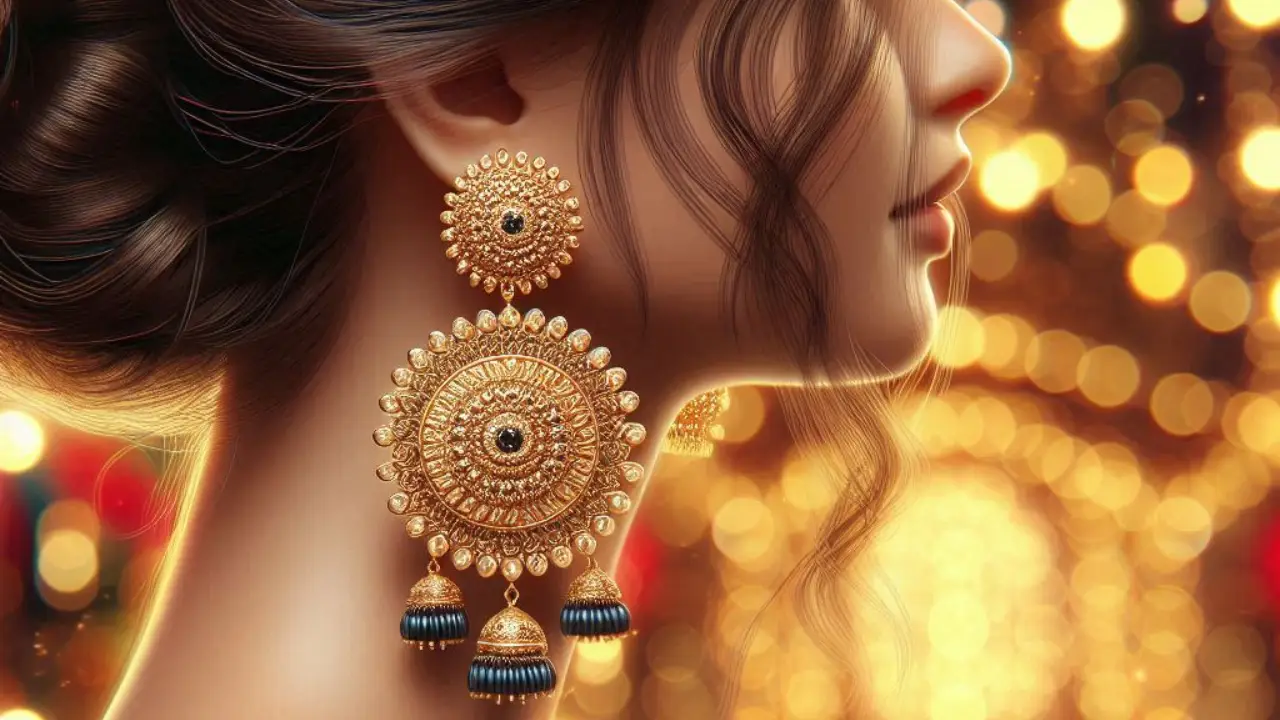From the bustling streets of Mumbai to the serene lanes of Jaipur, India’s diverse landscape is adorned with a plethora of traditions, each weaving its unique narrative into the cultural fabric of the nation. Among these, one aspect that gleams with splendor and significance is India’s rich earring culture. From the iconic jhumkas to the intricate chandbalis, Indian earrings not only adorn the ears but also carry tales of tradition, craftsmanship, and symbolism.
Exploring the Magnificence of Indian Earrings
In the heart of India’s bustling markets, the tinkling sound of earrings catches the attention of passersby. This sound invites them to explore the vibrant array of designs. Each region of India boasts its distinctive style of earrings. These styles reflect the diverse heritage and craftsmanship passed down through generations.
The Timeless Charm of Jhumkas
No discussion of Indian earrings is complete without mentioning the timeless charm of jhumkas. These bell-shaped beauties trace their roots back to ancient times, where they adorned the ears of royalty and commoners alike. Crafted in a myriad of materials ranging from gold and silver to intricate filigree work, jhumkas are a symbol of femininity and grace. Whether worn with a traditional saree or a contemporary ensemble, jhumkas add a touch of elegance to any outfit.
Chandbalis: Crescent-shaped Elegance
Another iconic symbol of India’s earring culture is the chandbali, named after its resemblance to the crescent moon. Chandbalis originated in the courts of the Mughal emperors and feature a crescent-shaped design. Artisans adorn these earrings with intricate embellishments like pearls, enamel work, and precious stones. Majestic and regal, they exude a sense of splendor. Chandbalis are often passed down as cherished heirlooms from one generation to the next.
Regional Variations and Symbolism
Beyond jhumkas and chandbalis, India’s earring culture is a tapestry of regional variations and symbolism. In the deserts of Rajasthan, colorful enamel earrings known as meenakari adorn the ears of women, while in the lush greenery of Kerala, intricate gold earrings known as kaasumala are a symbol of prosperity and tradition. Each region infuses its unique flavor into the design, materials, and motifs of its earrings, reflecting the cultural diversity of the Indian subcontinent.
Craftsmanship and Tradition
At the heart of India’s earring culture lies the craftsmanship and tradition passed down through generations of artisans. From the skilled hands of goldsmiths in Karnataka to the intricate embroidery of threadwork earrings in Gujarat, each pair of earrings tells a story of dedication, passion, and artistry. The craftsmen closely guard the family secret involved in creating these pieces, handing down the tradition from master to apprentice, ensuring that each earring carries a legacy of skill and tradition.
Earrings Beyond Adornment
In addition to their aesthetic appeal, Indian earrings also carry deep symbolism and significance. Many cultures across India believe that earrings have therapeutic properties, attributing healing energies to materials like gold and silver. Earrings are also a symbol of marital status, with newly married women often adorned with elaborate earrings as a sign of their newlywed status.
Innovations and Contemporary Trends
While traditional designs continue to hold sway in Indian earring culture, there is a growing trend towards innovation. Contemporary designers are blending traditional motifs with modern materials and techniques. They are creating earrings that appeal to a new generation of fashion-conscious consumers. From minimalist designs to bold statement pieces, Indian earrings are evolving. They reflect the changing tastes and preferences of today’s society.
Preserving Heritage in a Modern World
As India embraces globalization and modernity, there is a growing awareness of the need to preserve traditional crafts and heritage. Organizations and artisans are working together to promote traditional earring-making techniques. They provide support for craftsmen to ensure that these age-old traditions are not lost to time. By supporting handmade and artisanal earrings, consumers play a vital role in preserving India’s rich cultural heritage. This ensures future generations can enjoy these traditions.
Embracing India’s Earring Culture
As India continues to evolve and embrace modernity, its earring culture remains a steadfast reminder of the nation’s rich heritage and traditions. Whether worn as a fashion statement or a nod to tradition, Indian earrings continue to captivate hearts and minds around the world.
So, the next time you adorn your ears with a pair of jhumkas or chandbalis, take a moment to appreciate the craftsmanship, symbolism, and stories woven into each delicate design.
I would love to hear your thoughts on India’s rich earring culture. Share your favorite pair of Indian earrings or any stories you have about them in the comments below!





